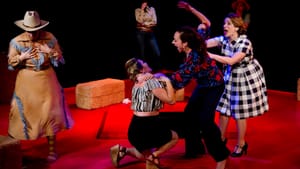Stay in the Loop
BSR publishes on a weekly schedule, with an email newsletter every Wednesday and Thursday morning. There’s no paywall, and subscribing is always free.
The man behind the curtain
EgoPo's revival of 'The Women'

The Women by Clare Boothe Luce is all about men — how to get them and how to keep them. The men are never seen, but they are always present, whether as the subject of conversation or as the other participant in a phone call.
This also describes a director, who is omnipresent but never visible. The 1939 film version of The Women had females in 130 roles, but the director, George Cukor, was a man. The same goes for this new production at EgoPo Classic Theatre: All 19 roles are played by women, but the director, Lane Savadove, is a man.
EgoPo’s decision to highlight classic plays written by women this season was applauded after last season’s male-dominated selections. However, one of the challenges in mounting women’s work is the choice of a director. It’s fine to say gender doesn’t matter, but handing over women’s work to a male director does make a difference — it sometimes works and sometimes alters the original intent of the script.
In this case, despite the evident talent of the cast, the voice of the director was apparent throughout, which led to some rather unsettling moments. Usually Lane Savadove’s over-the-top yet thoughtful direction adds to a classic, but this time it does not seem to advance the conversation.
An unnecessary revival
Of course, it’s a problematic choice of production to begin with. One of the challenges of staging historical plays by women, and in this case about women, is that in earlier eras, women, as well as men, were affected by the limited scope of women’s lives. When Diane English created an updated version of the movie in 2008, she gave the women jobs as well as husbands and lovers. This EgoPo production, electing to stick with the original script, is also stuck with its original concepts. In today’s world of Real Housewives, is a revival of this play even necessary?
The plot is simple. Mary Haines (Melanie Julian) is a happily married woman who learns her husband is cheating on her, divorces him, and then regrets her decision. She is egged on by a set of really annoying friends who go through their own marital ups and downs. It’s a bitter, sarcastic play about friendship and betrayal and women’s place in the world and no one comes off well. In Savadove’s exaggerated version, everyone is just that much more irritating.
The Women is, ironically, a play by a woman about women that fails the Bechdel test (two named women who talk about anything other than a man). And of course any production that insults women by turning them into caricatures is baffling. This production is a letdown on both counts.
I walked out disliking every character in the play and wondering what I had learned to advance the discussion of women’s issues. In this version the women are all crass and conniving: they don’t pretend to be smart or wealthy or even nice. Every cliché is played to the max. The blonde bombshell Crystal Allen (Colleen Murphy) enacts her big scenes in bra and garter belt or surrounded by soap suds in the bath. A poorly staged cat fight at a Reno dude ranch is unconvincing. It’s hard to parody satire. The result is broad schtick that rather than insightful humor.
Mirroring the egotists
Some choices are more successful than others. A scene in which two servants reenact the major breakup scene between their master and mistress works well, and the use of mirrors constantly reflecting the actors back to themselves hints at the egotism of all the characters. On the other hand, forcing characters in fancy dresses to sit on pillows on the floor feels forced and improbable. Most difficult of all is the handling of how Little Mary, played by Courtney Bundens, comes into womanhood.
This was a coproduction with advanced acting students at Rowan University, where Savadove teaches. It is a wonderful opportunity for students to work with professional actors, and they do a good job of matching the professionals throughout. However, the students, for the most part, play servants dressed in short black dresses and bare feet and scoot around in the background. Is this a way of saying this is where women belong — barefoot and silent? The only explanation I could come up with for their presence seemed to be that they represented the spirit of malice and gossip that permeated the play.
To blame all this on gender is unfair. But as I watched the women doing things on stage that felt forced and unnatural, I was very aware that they were doing what they were told to do by a man, and it felt distinctly uncomfortable.
What, When, Where
The Women. By Clare Boothe Luce. Lane Savadove directed. Presented by EgoPo Classic Theater. Through March 20, 2016 at the Latvian Society, 531 N. 7th Street, (7th and Spring Garden Sts.), Philadelphia. 267-273-1414 or egopo.org
Sign up for our newsletter
All of the week's new articles, all in one place. Sign up for the free weekly BSR newsletters, and don't miss a conversation.

 Naomi Orwin
Naomi Orwin